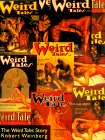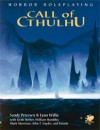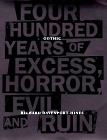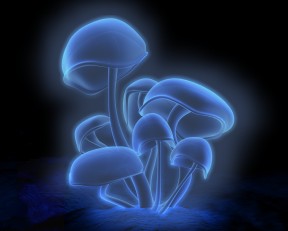
| ęCopyright 2002-2008 [Shawn Nacol] All rights reserved |
Here are some books to peruse if you're intrigued by the world of Drawing Monsters:
by L. Sprague De Camp This is the book that started it all. I'd been reading Lovecraft since I was a kid, and picked this up out of casual interest in Lovecraft's bizarre life. In 1996, I was sitting on a crosstown bus reading this chatty and gripping biography when I stumbled across a cursory paragraph about "Mrs. Margaret Brundage" using "her daughters"... I got very excited about the theatrical potential of the Brundage girls, Depression-era Chicago, the birth of modern horror fiction, the weird anti-relationship between Brundage and Lovecraft, and dog-eared the page vehemently. All the pieces were on the page. I saw the play taking shape immediately, and knew I wasn't mature enough to write it yet. Little did I know that this short throwaway Brundage paragraph would lead me through thousands of pages of research and years of gothic exploration. Nevertheless, from the moment I read that paragraph, I was certain I would write the play when the time was ripe and that it would challenge and change me forever. On rereading, after a LOT of genuine research, I still enjoy this book as a lighter biography, but I have to admit that it's less than thorough, a little too reliant on pop-psychology, and strangely biased in its interpretations of events and motives. | |
by Robert Weinberg THE book on Weird Tales magazine, covering its publishing history from 1923 until its death in the 1950s. Lots of info, lots of pictures, lots of anecdotes from famous contributors to "The Unique Magazine" throughout its lifespan. This book won a World Fantasy Award for Mr. Weinberg when it first came out. A definite must-have for any weird fiction collector. Weinberg, aside from being a very cool guy, is one of the foremost authorities on Weird Tales, and maintains one of the largest pulp collections in the world... | |
by S. T. Joshi Brilliant and exhaustive... without ever exhausting the mystery and magic of its topic. The definitive biography. Scrupulously detailed and researched. Packed with interesting facts and strange footnotes. A must-read for any HPL aficionado.
Lord of a Visible World: an autobiography in letters "by" H. P. Lovecraft; edited by S. T. Joshi (again! can you tell I love this guy?) A phenomenal read that makes you feel personally connected to HPL. Lovecraft speaks for himself in hundred of epistolary excerpts edited and compiled by Mr. Joshi. Fascinating and compelling. It was in this book and the 5 volumes of Collected Letters published by Arkham House that I got a handle on Lovecraft's voice. | |
Lovecraft : A Study in the Fantastic by Maurice Levy Readable, intriguing critical study of Lovecraft's work that traces significant themes throughout his stories: dreams, forbidden books, ancient cults, ancestry, subterranean worlds, dark myths, etc.. A terrific, if slight overview of HPL's obsessions. A superb introduction to a critical reading of Lovecraft's body of work and recurring concerns. | |
The Annotated Supernatural Horror in Literature The Shadow out of Time: The Corrected Text all by H. P. Lovecraft all edited by S. T. Joshi
Definitive editions of Lovecraft's writing complete with massively detailed annotations and scrupulous attention to reconstruction of pristine texts. | |
The Call of Cthulhu & Other Weird Stories The Thing on the Doorstep & Other Weird Stories by H. P. Lovecraft Penguin's highbrow Lovecraft collections. Terrific collections for someone wanting a good selection of stories to sample. The annotations by Joshi are relegated to endnote status, making it a little harder to cross reference things. These are the editions I suggest to people who ask for a casual introduction to HPL's writing. | |
by Willis Conover & H. P. Lovecraft Amazon: "Surprisingly relaxed and informal view of HPL in a book built of a series of letters, written in 1936-37, exchanged between Howard Phillips Lovecraft and Willis Conover, a 12-year-old boy at the time. A very intimate look at the father of modern horror literature." | |
Living in Fear : a History of Horror in the Mass Media by Les Daniels Cursory survey of Horror's growth as a cultural phenomenon over the course of history. Has a short section on the pulps and a brief bit on Brundage and "her girls".
| |
Shudder Pulps: A History of the Weird Menace Magazines of the 1930's by Robert Kenneth Jones A commendable book that lovingly documents the structures and history of the shudder pulp genre. Amazon: "Jones's book focuses on the subgenre of pulp known as the "weird menace" tale. Due to the sensational nature of these stories they were neglected. Jones was one of the few original critics in this area. His book covers different magazines, publishers, and authors. He also focuses on different conventions within the subgenre."
|
|
Walt Disney: An American Original by Bob Thomas This isn't as random as it might seem. Disney was a Depression-era Chicago illustrator who knew Margaret Brundage for decades. This book is a terrifically readable biography of the man behind the Mouse. Lots of juicy historical detail. I read this because of Disney's early days in Chicago, the time he spent in High School and the Academy with Brundage, and the job offer he made to her later on... Only shreds of that research survive in the play, but nevertheless... | |
The Dark Barbarian: The Writings of Robert E Howard: A Critical Anthology by Don Herron (Editor) Amazon: "Thoughtful, scholarly, and a helluva read. A fantastic book that is something of a classic of its kind. A fascinating book for anyone interested in Howard's work and life." |
|
Cthulhu: The Mythos and Kindred Horrors Amazon: "An excellent introduction to Robert E. Howard's non-heroic fantasy tales (no Conan, Kull or Solomon Kane stories here). Includes some of Howard's most compelling stories, especially "Pigeons from Hell" and "Worms of the Earth." Only about half the 13 items in the book have anything even remotely to do with H.P. Lovecraft's "Mythos," but it's a graphic illustration of what a born talented storyteller Howard was." | |
Call of Cthulhu: Horror Roleplaying by Sandy Petersen & Lynn Willis Core rules for the popular role-playing game set in the worlds of H. P. Lovecraft's fiction. Investigators fight to keep their sanity as they poke into dark corners better left unlit. This game and its offshoots have been responsible in large part for the continued growth of Lovecraft's cult following... Edition 5.6.1 | |
by John Strysik & Andrew Migliore Excellent book detailing adaptations of H. P. Lovecraft in film, television & other recorded media... | |
Gothic fiction & criticism:
by Umberto Eco An edge of your seat read! A dazzling postmodern thriller about literary joke that plunges its perpetrators into deadly peril... included here because a few people have pointed out similarities in tone, topic and construction between it and Drawing Monsters. Randomly, the novel's pivotal moment even contains a brief, potent reference to Cthulhu & Lovecraft. | |
The Name of the Rose, including the Postscript to the Name of the Rose by Umberto Eco Spectacular. Eco's "Postscript" is worth the price of the book in itself... published finally with the book that inspired it. But the novel, an event when it was first published, is phenomenal, totally deserving of its success. Smarty-pants fiction with a lingering glow. | |
by Henry James Henry James' short masterpiece of gothic terror and ambiguity. Riveting and elusive. In the hands of James, the master of nuance, this little tale of terror is an exquisite gem of sexual and psychological ambiguity. Virginia Woolf said of this masterpiece, "We are afraid of something unnamed, of something, perhaps, in ourselves...Henry James...can still make us afraid of the dark." | |
and while you're at it, if you can track it down, you might as well just pick up: A Casebook on Henry James's the Turn of the Screw Packed with insight and illuminating inquiry. This book includes the original novella and a collection of all of the major criticism relating to it, going all the way back to James later thoughts in The Aspern Papers and the initial critical responses to the book. A feast of gothic ideas. |
|
The Gothic Impulse in Contemporary Drama (Theatre and Dramatic Studies, No 63) by Mary Beth Inverso A very cool examination of the gothic themes and structures used in 20th century drama. Presents a terrific rubric for examining post-modern theatrical writing and its impulses. Impossible to find but worth tracking down (esp. the 1st. edition hardcover if you can locate one). From Book News, Inc.: "Inverso (English, Bentley College) examines a wide spectrum of Gothic texts--including The Castle of Otranto, Dracula, and The Turn of the screw--and illustrates how various Gothic narrative motifs and conventions are present in New Gothic drama. Modern plays discussed include Harold Pinter's The Caretaker, Peter Barnes's The Ruling class, and Peter Weiss's Marat/Sade." | |
by Jack Morgan Really interesting revisiting of the dynamic of horror in literature as an expression of the death-impulse. Argues that the split in literature isn't comedy/drama, but rather comedy/horror. Eros/Thanatos and all that, natch. Very cool reading. Caitlin Kiernan: "An eminently readable and insightful book . . . a must for readers interested in the history and deeper significance of the gothic." | |
The Thrill of Fear: 250 Years of Scary Entertainment by Walter M. Kendrick Great read, packed with facts and insight. From Kirkus Reviews: "In The Secret Museum (1987), Kendrick traced the rise and influence of literary pornography. Here, in an equally freewheeling study, the Fordham English professor excavates another cultural back-alley--that of horror literature and film. Kendrick's basic thesis is two-fold: that horror arises from ``the fear of being dead,'' and that, since this fear is endemic to the modern (i.e., post-1750) condition, horror entertainments tend to recycle the same themes and styles... Of most value for its in-depth look at the genre's seminal works." | |
by Harry M. Benshoff Fascinating criticism of the monsters of in Hollywood horror film from a gender-challenging perspective. Astute jargon-free exploration of sexuality as monstrous and monsters as fundamentally sexual. Some ideas that were especially useful as I was working on Lovecraft's ambiguous, tortured sexual self. Amazon.com: "They are half-human horrors, strange and scary aliens, the seemingly-normal-but-deadly danger that lurks around the corner: Hollywood monsters, or homosexuals? Horror fiction has always portrayed society's greatest fears as monstrous incarnations of "the other," so it should be no surprise that there has always been a clear homoerotic subtext in horror films... Harry M. Benshoff's Monsters in the Closet details how Hollywood monsters have not only been a reflection of homosexuals, but that changes in the horror film have actually mirrored changes in attitudes toward homosexuality in our society. Discussing hundreds of classic (and not so classic) movies, Benshoff provides new insight into horror and science fiction films and into how popular culture presents ideas about homosexuality to a broad audience." | |
Gothic: Four Hundred Years of Excess, Horror, Evil and Ruin by Richard Treadwell Davenport-Hines Interesting nonlinear tour through Gothic work beginning with the eruption of Vesuvius in the 17 century, which he sees as pivotal... From Library Journal: "The enduring interest in Gothic and macabre images and stories has drawn the attention of contemporary scholars and critics. Departing from recent volumes that analyze the Gothic in contemporary culture and arts, British critic Davenport-Hines has produced a comprehensive survey of Gothic themes in art, architecture, literature, and film since the early 17th century." | |
The Return of the Repressed: Gothic Horror from the Castle of Otranto to Alien by Valdine Clemens Amazon: "This is a very readable, intellectually serious, and balanced approach to the importance of Gothic literature and film to our culture. Clemens takes what is essentially a Jungian or archetypal close-reading approach to a number of classic and some newer texts... but here's what sets this book apart: a thorough and fascinating grounding in social and political history, and a willingness to take the Gothic seriously even in its current manifestations." | |
by Fred Botting Brief but meaty survey of the Gothic. From jacket: "Traces the history of the gothic and cultural significance of the form, from its beginnings in the 18th cent. to modern times. Takes the student from basic material towards the more subtle in an accessible way." | |
The Art of Darkness: a Poetics of Gothic by Anne Williams From Book News, Inc.: "The author proposes that the Gothic tradition in literature is a poetic tradition with intimate links to the Romantic, with subjects in both a male and a female genre. She observes that the structure informing the Gothic myth is the patriarchal family, and explains how the tradition as a whole expresses the dangerous power of the female." | |
by David Stevens Slick intro to basic gothic history & criticism. From jacket: "From a series that allows contextual study of texts by concentrating on key periods, topics and comparisons in literature. Each book adopts an interactive approach and provides the background for understanding the significance of literary, historical and social contexts." | |
The Contested Castle: Gothic Novels and the Subversion of Domestic Ideology by Kate Ferguson Ellis From jacket: "The Gothic novel emerged out of the romantic mist alongside a new conception of the home as a separate sphere for women. Looking at novels from Horace Walpole's Castle of Otranto to Mary Shelley's Frankenstein, Kate Ferguson Ellis investigates the relationship between these two phenomena of middle-class culture--the idealization of the home and the popularity of the Gothic--and explores how both male and female authors used the Gothic novel to challenge the false claim of home as a safe, protected place. Linking terror -- the most important ingredient of the Gothic novel -- to acts of transgression, Ellis shows how houses in Gothic fiction imprison those inside them, while those locked outside wander the earth plotting their return and their revenge." | |
Skin Shows: Gothic Horror & the Technology of Monsters by Judith Halberstam A little too cool for school but still worth a look for the ideas buried in the smarty-pants theorizing. H-Net Reviews calls Skin Shows an "intelligent, well-informed, and provocative piece of writing" and writes that its "greatest strength ... is that it allows for other critics of the Gothic to proceed more self-consciously about the presuppositions that particularly psychoanalysis has introduced into the academic discussion." One caveat, though: the language is somewhat turgid, with awkward verbs such as "gothicize" and "metaphorize." | |
The Gothic Family Romance: Heterosexuality, Child Sacrifice, and the Anglo-Irish Colonial Order by Margot Gayle Backus From jacket: "Tales of child sacrifice, demon lovers, incestual relations, and returns from the dead are part of English and Irish gothic literature. Such recurring tropes are examined in this pioneering study by Margot Gayle Backus to show how Anglo-Irish gothic works written from the eighteenth through the twentieth centuries reflect the destructive effects of imperialism on the children and later descendents of Protestant English settlers in Ireland. " |
 |
|






























